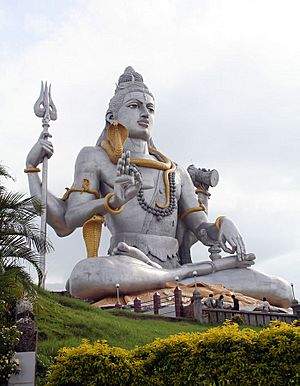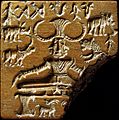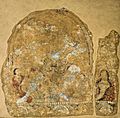Shaivism facts for kids
Shaivism is a major branch of Hinduism. People who follow Shaivism believe that Shiva is the most important deity (god). They see Shiva as the Supreme Being, who creates, protects, and transforms the universe.
Shaivism is practiced in many different ways around the world. It is very common in countries like India, Nepal, and Sri Lanka. You can also find followers of Shaivism in Malaysia, Singapore, and Indonesia.
Contents
Who is Shiva?
Shiva is one of the main gods in Hinduism. He is often called "The Destroyer" or "The Transformer." This does not mean he is evil. Instead, it means he helps to end old things so new things can begin. Shiva is also seen as the master of yoga and meditation. He is often shown with a third eye on his forehead, which represents wisdom.
Symbols of Shiva
Shiva is connected to several important symbols:
- Trident (Trishula): This three-pronged spear represents Shiva's power over creation, preservation, and destruction.
- Crescent Moon: A crescent moon on his head symbolizes time and his control over it.
- Snake: A snake around his neck shows his power over dangerous creatures and his ability to stay calm.
- Ash: Shiva often has ash smeared on his body, which reminds followers that everything eventually turns to dust.
- Nandi the Bull: Nandi is Shiva's loyal animal companion and vehicle. He represents strength and purity.
How Shaivism Started
The ideas behind Shaivism are very old. Some historians think they might even go back to the Indus Valley Civilisation (around 2500-1900 BCE). An ancient seal found there, called the "Pashupati" seal, shows a figure that some believe looks like an early form of Shiva.
Over thousands of years, the worship of Shiva grew and changed. Different groups and teachers developed their own ways of understanding and following Shaivism.
Different Ways to Practice Shaivism
Shaivism is not just one single way of worship. It has many different traditions, or "schools," each with its own beliefs and practices. Some of the main types include:
- Pashupata Shaivism: This is one of the oldest known Shaiva traditions. Its followers often practice strict spiritual exercises.
- Shaiva Siddhanta: This tradition is very popular in South India. It focuses on the idea that Shiva is the ultimate reality and that souls can achieve liberation through his grace.
- Kashmiri Shaivism: This school developed in Kashmir. It teaches that everything in the universe is a part of Shiva, and that realizing this can lead to spiritual freedom.
- Nath Tradition: This group focuses on Hatha Yoga and meditation to achieve spiritual power and a deeper connection with Shiva.
- Lingayatism: This tradition is mainly found in Karnataka, India. Followers wear a small lingam (a symbolic representation of Shiva) around their neck. They believe in one God, Shiva, and reject the caste system.
Worship and Festivals
Followers of Shaivism often worship Shiva in temples or at home. They might offer prayers, sing hymns, and perform rituals. A common way to worship Shiva is through the lingam, which is a symbol representing his creative energy.
One of the most important festivals for Shaivites is Maha Shivaratri. This festival celebrates Shiva and is a night of prayer, fasting, and meditation. People stay awake all night, singing devotional songs and offering prayers to Shiva.
Shaivism Today
Shaivism continues to be a very important part of Hinduism around the world. It teaches about the power of transformation, the importance of spiritual practice, and the idea that the divine is present everywhere. Many people find peace and meaning in following the path of Shiva.
Images for kids
-
The "Pashupati" seal from the Indus Valley Civilisation.
-
Kushan Empire coin of Vima Kadphises (2nd century CE), with a possible Shiva, holding a trident, and next to a bull, his mount, as in Shaivism.
-
Shiva with Trisula, worshipped in Central Asia. Penjikent, Uzbekistan, 7th–8th century CE. Hermitage Museum.
-
An image collage of 1st millennium CE Shaivism icons and temples from Southeast Asia (top left): Shiva in yoga pose, Nandi, Prambanan temple, Yoni-Linga and Hindu temple layout.
-
Kauai Hindu monastery in Kauai Island in Hawaii is the only Hindu Monastery (Shaivaite) in the United States.
-
Goraknath founded the Nath Shaiva monastic movement.
-
Shaivism and Buddhism have co-developed in many regions. Above a syncretic image of Yoni-Linga with four reliefs of the Buddha in a Vajrayana temple.
See also
 In Spanish: Shivaísmo para niños
In Spanish: Shivaísmo para niños


















